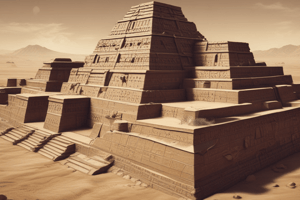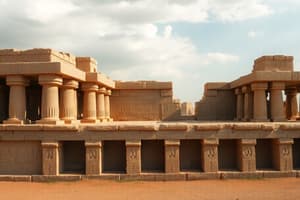Podcast
Questions and Answers
What was a significant factor in the decline of the Sumerian civilization?
What was a significant factor in the decline of the Sumerian civilization?
- The construction of ziggurats.
- The development of a writing system.
- Political instability and power struggles among city-states. (correct)
- The introduction of a sexagesimal number system.
What feature of Sumerian society is reflected in their art and architecture?
What feature of Sumerian society is reflected in their art and architecture?
- The importance of agriculture.
- The emphasis on individual expression.
- The lack of religious beliefs.
- The reverence for gods, goddesses, and rulers. (correct)
What innovation in mathematics had a long-lasting impact on later civilizations?
What innovation in mathematics had a long-lasting impact on later civilizations?
- The use of symbols to represent numbers.
- The adoption of a sexagesimal number system. (correct)
- The invention of the abacus.
- The development of a calendar system.
What is a key characteristic of Sumerian art and architecture?
What is a key characteristic of Sumerian art and architecture?
What evidence provides insights into Sumerian daily life and customs?
What evidence provides insights into Sumerian daily life and customs?
Which of the following statements accurately describes the geographic location of Sumer?
Which of the following statements accurately describes the geographic location of Sumer?
Which of the following was NOT a key city-state of Sumer?
Which of the following was NOT a key city-state of Sumer?
What was the primary source of economic prosperity in Sumer?
What was the primary source of economic prosperity in Sumer?
What impact did the development of irrigation systems have on Sumerian society?
What impact did the development of irrigation systems have on Sumerian society?
What was the main purpose of ziggurats in Sumerian society?
What was the main purpose of ziggurats in Sumerian society?
How did the development of cuneiform writing impact Sumerian society?
How did the development of cuneiform writing impact Sumerian society?
What was the nature of the political organization among Sumerian city-states?
What was the nature of the political organization among Sumerian city-states?
Which of the following statements accurately describes the role of religion in Sumerian society?
Which of the following statements accurately describes the role of religion in Sumerian society?
Flashcards
Sumerian Writing System
Sumerian Writing System
A system for recording history, laws, and transactions, notable in Sumerian civilization.
Sexagesimal Number System
Sexagesimal Number System
A base 60 number system developed by the Sumerians, impacting future mathematics.
Sumerian Ziggurats
Sumerian Ziggurats
Stepped pyramids that served religious purposes and showcased Sumerian architecture.
Sumerian Art and Culture
Sumerian Art and Culture
Signup and view all the flashcards
Decline of Sumerian Civilization
Decline of Sumerian Civilization
Signup and view all the flashcards
Sumer
Sumer
Signup and view all the flashcards
Fertile Crescent
Fertile Crescent
Signup and view all the flashcards
City-states
City-states
Signup and view all the flashcards
Irrigation
Irrigation
Signup and view all the flashcards
Ziggurats
Ziggurats
Signup and view all the flashcards
Cuneiform
Cuneiform
Signup and view all the flashcards
Polytheism
Polytheism
Signup and view all the flashcards
Social hierarchy
Social hierarchy
Signup and view all the flashcards
Study Notes
Geographic and Temporal Context
- Sumer was an ancient civilization located in Mesopotamia, in the southern region of modern-day Iraq.
- Its emergence occurred during the Chalcolithic and Early Bronze Age (circa 4000 to 2300 BCE).
- The area was situated between the Tigris and Euphrates rivers, a region often referred to as the Fertile Crescent.
- This region's fertile land and access to water resources were crucial for the development of agriculture.
Early Urbanization and Social Structure
- Sumerian society witnessed the development of cities, a major characteristic of civilization.
- Key city-states include Uruk, Ur, Lagash, and Nippur.
- These cities were centers of political, economic, and religious life.
- A hierarchical social structure existed, with rulers at the top, followed by priests, officials, and artisans.
- Commoners and slaves formed the lower classes.
Farming and Economy
- Agriculture was the cornerstone of the Sumerian economy.
- Irrigation techniques were crucial for controlling water flow in the fertile valleys.
- Farmers cultivated crops such as barley, wheat, and dates.
- The development of irrigation systems allowed for surplus production, supporting a growing population and specialization of labor.
- Trade networks expanded, connecting Sumer to other regions, facilitating the exchange of goods and ideas.
Political Organization
- Sumerian political organization was characterized by city-states.
- Each city-state was governed by a ruler who held both secular and religious authority.
- Conflicts between city-states were common, as competition for resources and power intensified.
- The rise of kingship marked a transition from earlier forms of leadership.
- Rulers established centralized control over their territories, although the degree of centralized control varied.
Religious Beliefs and Practices
- Religion played a central role in Sumerian society.
- Polytheistic beliefs centered on a pantheon of gods and goddesses associated with natural forces and human activities.
- Temples, called ziggurats, were the focal points of religious life, serving as monumental structures and centers for rituals.
- Priests held significant power and influence, mediating between the gods and humans.
Technological Advancements
- Sumerians made significant strides in various fields.
- Cuneiform writing, a system of writing using wedge-shaped marks on clay tablets, was a remarkable development.
- This system allowed for the recording of history, laws, religious texts, business transactions, and other important information.
- Innovations in mathematics, including a sexagesimal number system (base 60), had lasting impact on later civilizations.
- Engineering advancements included sophisticated irrigation systems, and infrastructure like canals and cities.
Artistic and Architectural Contributions
- Sumerian art and architecture reflected religious and cultural values.
- Sculptures, often depicting gods, goddesses, and rulers, highlighted the importance of these figures.
- Frescoes and pottery provided insights into the daily life and customs.
- Ziggurats, towering stepped pyramids, stood as magnificent architectural achievements.
Decline and Legacy
- The Sumerian civilization eventually declined in influence and power.
- Factors such as political instability, power struggles among city-states, and external pressures likely contributed to its downfall.
- The legacy of Sumer was profound.
- Their innovations in writing, mathematics, and governance laid the foundation for future civilizations in Mesopotamia and beyond.
- Cultural and technological advancements had a long-lasting influence on the development of human society.
Studying That Suits You
Use AI to generate personalized quizzes and flashcards to suit your learning preferences.




